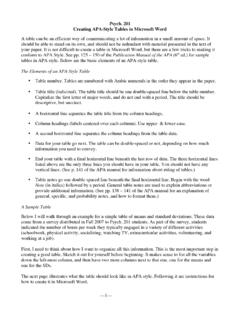Transcription of Basil (Ocimum basilicum)
1 1 Herbs Entry prepared by Christopher Sullivan 09 in College Seminar 235 - Food For Thought: The Science, Culture, & Politics of Food in Spring 2009. Basil (Ocimum basilicum) Scientific Classification Kingdom Plantae Phylum Magnoliophyta Class Magnoliopsida Order Lamiales Family Lamiacaea Genus Ocimum Species O. basilicum Scientific Classification and Etymology Basil belongs to the genus Ocimum, derived from the Greek ozo which means to smell, in reference to the strong odors of the species within the In French, it is frequently given the name Herbe Royale, revealing the positive light in which it is The etymology of Basil is unclear, however several potential sources are plausible.
2 It is sometimes referred to as the king of herbs, and may have been derived from the Greek basileus, or Basil s affiliation with the crown may be in part due to its use in regal Basil may come from the Latin basilisk, or dragon; this etymological connection may explain the symbolic connection between Basil and scorpions (see Cultural Significance and History). Origin and Distribution Basil is native to areas in Asia and Africa and grows wild as a perennial on some pacific Basil was brought from India to Europe through the Middle East in the sixteenth century, and subsequently to America in the seventeenth Cultural Significance and History Basil is one of the most important herbs to many cultures and cuisines, including Italian, Thai, Vietnamese, and Laotion.
3 The Basil variety tulsi (Ocimum tenuiflorum, previously Ocimum sanctum7) is a sacred herb in the Hindu religion8; indeed, while Basil is used relatively sparsely in Indian cuisine, tulsi is considered In Hindu houses, Basil is the protecting spirit of the The British at one time used tulsi as a substitute for a Bible upon which the Indians would take an oath in a court of 2 The scorpion is historically associated with Basil , which is likely due to the potential derivation of the name from the Latin basilisk. It was advised to handle Basil gently as to avoid the breeding of scorpions.
4 Scorpions were believed to seek out Basil pots to rest under, and superstition taught that a sprig of Basil left on its own underneath a pot would eventually turn into a Similarly, a sixteenth century Flemish doctor wrote of his belief that crushed Basil left between bricks would turn into Perhaps the most outlandish of the scorpion-related superstitions, as affirmed by the French doctor Hilarius, was that smelling Basil would breed a scorpion in the While considered of great significance throughout much of history and in many cultures, in the 1980s the British Ministry of Agriculture s bulletin on herbs stated Basil to be of little or no importance.
5 15 Hindus and most other modern consumers would likely disagree. 19th Century American Significance Newspaper advertisements reveal that sweet Basil has been sold and grown in New York State since the end of the 18th It is likely that the cultivar of Basil grown at this time was lettuce-leaf Basil , as referenced in Vilmorin s The Vegetable Garden (1885).17 Botanical Description The botanical differences between varieties of Basil are plentiful; for this reason a universal description of the herb is inadequate. Sweet Basil (Ocimum basilicum) will grow to a size of 1-2 feet in Basil will prolifically produce large green leaves, measuring around 2 inches in length, throughout the Basil flowers are white, and are commonly removed to increase yield of Cultivars of sweet Basil include Lemon Basil , Italian or Curly Basil , and Lettuce-leaf Basil ; the names of these cultivars give way to their variances.
6 Bush Basil (Ocimum mimimum L.), is smaller in size and more compact than sweet Basil . Bush Basil grows to a height of around 10 inches with leaves of a maximum length of Its flavor is less vigorous than that of sweet Basil and is grown primarily as a decorative Basil has the ability to synthesize and convert phenylpropenes (important chemicals in determining the flavor of herbs which can also act as cultivator attractants or herbivore deterrents).23 The flavor and smell of Basil varieties is largely determined by their chemical components Basil varieties contain the following oils in varying quantities: cinnamate, citronellol, geraniol, linalool, methyl chavicol, myrcene, pinene, ocimene, terpineol.
7 3 Cultivation Basil grows as a perennial in tropical climates, and is planted as an annual in temperate regions, where it may be sown directly from seed or While other members of the Basil family (Lamacaea) grow well under competitive circumstances, Basil prefers little competition for sun and As Basil is a highly frost sensitive plant, it must be protected against temperatures close to freezing. Basil prefers to be grown in full sun, however will grow (albeit with less vigor) in partial To avoid damping off disease, Basil should not be The leaves of the Basil plant are most commonly used and can be increased in yield by pinching off flowers as they appear throughout the growing Basil may be sown outside after there is no danger of frost, or started inside and transplanted outdoors for an earlier Seeds germinate in four or five days and remain viable for years if stored in dry Opinions vary on the optimal distance between plants and between rows of Basil .
8 8 inches between plants and rows may be used for efficient In colder climates and in winter, Basil may be productively cultivated indoors in Culinary Uses Basic is a popular culinary herb used in many cuisines including Italian and Thai. It is used both fresh and dried, however the predominant flavors diminish with drying. The uses of Basil are varied and plentiful; it is used with vegetables, meat, fish, sauces, stews, dressings, herbal teas, liqueurs, and mixed It is a traditional herb used in the preparation of turtle soup by the It is commonly used, both by the household and the industrial producer, in the preparation of pesto, a varying combination of Basil , oil, garlic, cheese, and Frequently, Basil is used as a complimentary flavor to tomatoes.
9 Fresh Basil is preserved in oil or vinegar, or Freezing Basil preserves the flavor of the herb more effectively than does The storage length of dried Basil far exceeds that of fresh Basil , which can be successfully stored in the refrigerator for a short Basil is best dried out of direct sunlight, which can brown the leaves in the drying Medicinal Uses Basil has been used as a folk remedy for an enormous number of ailments, including boredom, cancer, convulsion, deafness, diarrhea, epilepsy, gout, hiccup, impotency, insanity, nausea, sore throat, toothaches, and whooping cough40.
10 Basil has been reported in herbal publications as an insect Recent scientific research has investigated the health benefits associated with Basil s essential oils. Studies reveal the anti-viral, anti-microbial, antioxidant, and anti-cancer properties of the oils; further research is 43 4 Fennel (Foeniculum vulgare) Scientific Classification Kingdom Plantae Phylum Magnoliophyta Class Magnoliopsida Order Apiales Family Apiacaea Genus Foeniculum Species F. vulgare Scientific Classification and Etymology Fennel belongs to the genus Foeniculum, which means little hay in Latin, in reference to the hay-like appearance of the fennel The Greeks referred to fennel as marathron, from maraino, which means to grow thin.






